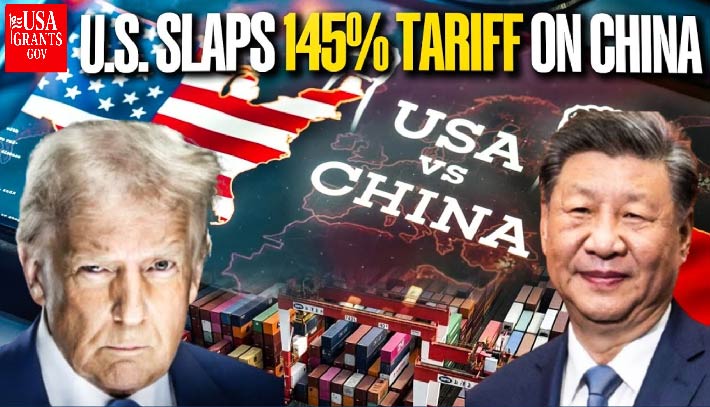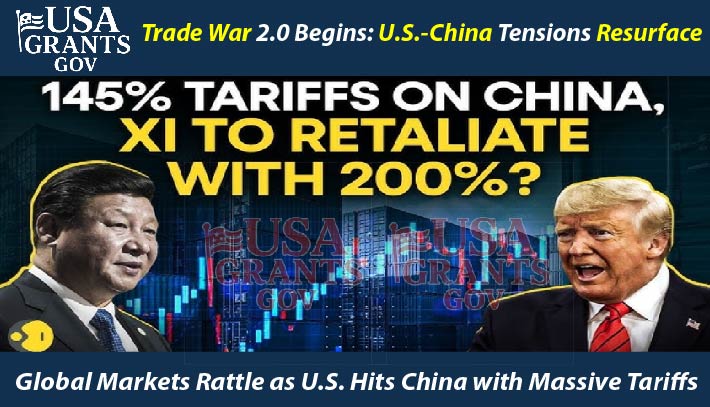Trade War Escalates In May 2025, former President Donald Trump made headlines by announcing a dramatic increase in tariffs on Chinese goods, raising rates up to 145%. The Chinese government responded swiftly, imposing retaliatory tariffs of up to 125% on U.S. products. This aggressive trade maneuver, reminiscent of the 2024–2025 trade war, has rekindled global concerns over supply chain disruptions, inflation, and geopolitical tensions.
This article provides a comprehensive overview of this tariff escalation: the motivations behind it, its economic implications for both countries, the global fallout, and potential paths forward.

Why Trump’s Trade War Escalates
Trump’s 2025 tariff hike came under the premise of “national emergency,” citing unfair trade practices by China, such as:
- Intellectual property theft
- Forced technology transfers
- State-subsidized manufacturing
- Trade imbalance with the U.S.
Trump’s 145% Tariffs on China 2025 tariffs as necessary to “rebalance trade and protect American workers and companies from economic aggression.” Trump also claimed China was manipulating currency and dumping cheap goods into the U.S. market.
The move is widely seen as part of Trump’s broader campaign strategy, appealing to his base in manufacturing-heavy states and reinforcing his tough-on-China rhetoric. Yet the decision has set off a chain reaction far beyond domestic politics.
Also Read : USAID Awards 28 New SME Growth Grants in 2025 to Boost Small Business Development in Pakistan
Economic Impacts on the United States Trade War Escalates
| 🔍 Impact Area | 📝 Details |
|---|---|
| 💰 Higher Consumer Prices | U.S. consumers are facing increased costs on goods like electronics, clothing, furniture, and auto parts due to tariff-driven price hikes. |
| 🏭 Business Disruptions | U.S. companies, especially small-to-medium ones, are struggling with supply chain issues, higher production costs, and reduced competitiveness. |
| 📈 Shipping Cost Spike | A Bloomberg report states that companies now face 30–40% higher import and shipping costs, which are being passed on to buyers. |
| 📉 Stock Market Volatility | Trade tensions have caused sharp dips in major stock indices, particularly affecting tech, global trade, and consumer sectors, sparking investor concerns. |
China’s Response and Economic Consequences
China’s Ministry of Commerce retaliated by announcing up to 125% tariffs on key U.S. exports, including:
- Soybeans and corn
- Semiconductors and tech components
- Medical equipment
- Luxury goods
Export Challenges Trump’s 145% Tariffs on China 2025
Chinese exporters are facing steep losses due to reduced access to the U.S. market—one of their largest. Many are cutting production or shifting to alternative markets in Southeast Asia, Latin America, and Africa.
Supply Chain Shifts Trade War Escalates
China is accelerating efforts to diversify its own import sources and reduce reliance on U.S. technology, particularly in chips, medical tech, and energy products.
Yuan Depreciation
In response to the tariffs, the Chinese yuan has slightly depreciated, making Chinese exports marginally more competitive but raising fears of a broader Trade War Escalates currency war.
Also Read : latest update apni zameen apna ghar scheme registration, eligibility criteria
Global Ripple Effects: Trade War 2.0 Trade War Escalates
| 🌍 Global Impact | 📝 Details |
|---|
| 🏭 Disrupted Supply Chains | Key global industries like electronics, autos, and pharma face delays and higher costs as tariffs hit goods crossing U.S.-China borders multiple times. |
| 📈 Inflation Concerns | The IMF and World Bank warn that ongoing tariffs may worsen global inflation, influencing central bank interest rate decisions. |
| 🧭 New Opportunities Emerge | Nations like Vietnam, Mexico, and India are benefiting from the “China Plus One” trend as firms seek more stable supply chain alternatives. |
Diplomatic Moves: Switzerland Talks Trade War Escalates
| 🤝 Diplomatic Engagements | 📝 Details |
|---|
| ⚖️ No Immediate Resolution | U.S. Treasury Secretary Scott Bessent and Chinese Vice Premier He Lifeng met in Switzerland, but no major breakthrough was achieved. |
| 💬 Muted Optimism | Analysts view the talks as diplomatic formalities unless real concessions are made. Both nations remain firm in their conflicting trade demands. |
Also Read : Apply for USA Circular Supply Chain Grant 2025 – Funding for Green Startups
What Happens Next? Possible Scenarios
Scenario 1: Gradual De-escalation
If diplomacy prevails, we could see a phased rollback of tariffs—particularly on essential goods like food and medicine. This would restore market confidence and ease pressure on consumers and businesses Trade War Escalates.
Scenario 2: Prolonged Trade War
If neither side backs down, the trade war could last into 2026 or beyond. This may lead to deeper decoupling of the U.S. and Chinese economies, long-term inflation, and geopolitical fragmentation in global Trade War Escalates trade alliances.
Scenario 3: Strategic Realignment
More companies could permanently shift production away from China, Trade War Escalates reducing dependency on both superpowers. New trade corridors may emerge, reshaping the global economy.
Key Developments of Trade War Escalates to Watch
| 🔮 What to Watch Next | 📝 Details |
|---|---|
| 💸 Tariff Adjustments | Monitoring whether the U.S. or China will revise tariff rates in response to economic strain or public pressure. |
| 🏭 Supply Chain Relocation | Companies may shift sourcing and manufacturing to other countries in real time, affecting global trade dynamics. |
| 🌐 Diplomatic Progress | Upcoming G20 or APEC summits could provide opportunities for significant diplomatic breakthroughs. |
| 🗳️ Public Opinion & Politics | With the U.S. election approaching, domestic opinion and political pressures may lead to changes in tariff or trade policies. |
Also Read : International Students 2025 US Visa Revocation Powerful Ways
Conclusion: A Defining Trade Moment
The 2025 tariff escalation marks one of the most significant economic confrontations between the U.S. and China since the original trade war. While the motives are rooted in long-standing grievances, the broader implications extend far beyond these two nations Trade War Escalates .
For businesses, the immediate focus is on cost management and supply chain flexibility. For consumers, rising prices are becoming an everyday reality. And for policymakers, the need to balance national interest with global stability has never been more urgent.
FAQ’s
Why did Trump raise tariffs on China in 2025?
To counter alleged unfair trade practices and protect American industries.
How high are the new tariffs?
The U.S. raised tariffs up to 145%, while China imposed retaliatory tariffs up to 125%.
What goods are most affected in the U.S.?
Electronics, clothing, auto parts, and furniture face significant price hikes.
How has China responded economically?
By targeting U.S. exports like soybeans, semiconductors, and medical devices.
